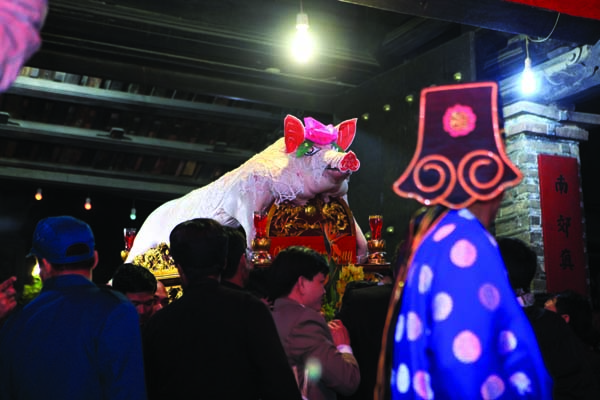(No.1, Vol.9,Feb-Mar 2019 Vietnam Heritage Magazine).jpg)
.jpg)
.jpg)
.jpg)
The processions of different hamlets are different in style. Some are accompanied by quan ho songs, some with life stories, dance, etc. Each procession has 3 palanquins: one carries godsends, one a tray of steamed sticky rice, and one with the Lord Pig.
.jpg)
.jpg)
.jpg)
The pig is slaughtered and then dressed in a coat of its own fat. At 6pm sharp, the Lord Pigs and other offerings begin parading along village streets and alleys under drum rolls before coming to the temple for the main ceremonies.
.jpg)
The Lord Pigs weigh from 180kg to 240kg.
.jpg)
Lion dance is another part of the festivities
Hoai Duc district is famous for its craft villages such as sculpture village Son Dong, garment village La Phu, farm produce village Zuong Lieu, rice vermicelli village Lower Cao Xa. Leaving Lord Pig festival tourists can visit:
n Quan Gia (Gia Temple), which is shared between villages Yen So and Dac So. It’s a tutelary god’s temple, not dedicated to any particular religion.
n The garment village La Phu, known for its export wool products such as scarves, sweaters, gloves, socks etc.
On the 13th of the first lunar month each year, villagers of La Phu village, Hoai Duc district of Hanoi have a procession to honor the “Pig Lord.” Records say that this is to commemorate the deeds of the Country Defender Tam Lang under the Sixth Hung King Zue.
Legends have it that before every battle, Lord Tam Lang had villagers cook rice and pork to treat his troops, and that’s how he defeated all his enemies. He has been conferred noble titles by Kings Le Dai Hanh, Tran Thai Tong, Le Thai To and Quang Trung of various dynasties. The glorious warrior was sanctified at midnight between the 13th and 14th of the 1st lunar month. Since then, on the 13th night of the 1st lunar month each year, La Phu villagers parade a pig to commemorate Lord Tam Lang’s death.
Early in the morning of the 13th day of the 1st lunar month, the master of ceremony of each hamlet receives a pig and makes a feast for the elders and butchers. Then, the pig is slaughtered and decorated smartly because it will contest for a prize at the end of the ceremony. The butcher has to hold the pig with his arms because no rope is allowed. The red flesh means the cut was unskilled. The skin has to be spotless and perfectly white, which means the pig must be bathed at a certain exact temperature before being shaved and cleaned.
After being gutted, the Lord Pig is put on a curved water pipe, which helps make it look alive as if standing stately, and then put on a palanquin about 1.2m high. The length and width of the palanquin depend on the size of the pig. The pig fixed on the palanquin, people begin decorating it with paper flowers and garlands of natural flowers. A crucial element which may decide the contest’s outcome is the “coat” of the Lord Pig, made of its own side fat.
At 18h that day, the “Lord Pigs” of the hamlets stand in queue to parade around the village before entering the village temple. The procession goes around village streets and alleys for hours until 21h when they gather in a neat line at the temple gate. The Lord Pigs ceremoniously enter the temple, announced and guided by the elders. At midnight sharp, the elders begin the consecration rituals which last until 2am the next day. The morning of the 14th, as villagers again gather in the temple courtyard, the elders announce the winning Lord Pig. The Lord Pigs are happily paraded back to the hamlets and divided among the households as a piece of godsend.
In these spring days, visitors who attend the Pig Parade at La Phu are sure to be fascinated by the eye- catching Lord Pigs, enjoy folk games, and most importantly be immersed in the unique festive culture of a suburban countryside of Hanoi.

